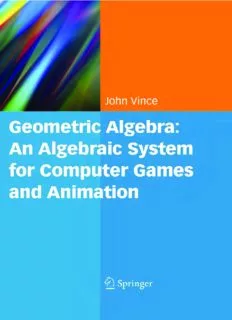Table Of ContentGeometric Algebra: An Algebraic System
for Computer Games and Animation
John Vince
Geometric Algebra:
An Algebraic System
for Computer Games
and Animation
Prof.JohnVince,MTech,PhD,DSc,CEng,FBCS
www.johnvince.co.uk
ISBN978-1-84882-378-5 e-ISBN978-1-84882-379-2
DOI10.1007/978-1-84882-379-2
SpringerDordrechtHeidelbergLondonNewYork
BritishLibraryCataloguinginPublicationData
AcataloguerecordforthisbookisavailablefromtheBritishLibrary
LibraryofCongressControlNumber:2009926270
(cid:2)c Springer-VerlagLondonLimited2009
Apart from any fair dealing for the purposes of research or private study, or criticism or review, as
permittedundertheCopyright,DesignsandPatentsAct1988,thispublicationmayonlybereproduced,
storedortransmitted,inanyformorbyanymeans,withthepriorpermissioninwritingofthepublishers,
or in the case of reprographic reproduction in accordance with the terms of licenses issued by the
CopyrightLicensingAgency.Enquiriesconcerningreproductionoutsidethosetermsshouldbesentto
thepublishers.
Theuseofregisterednames,trademarks,etc.,inthispublicationdoesnotimply,evenintheabsenceofa
specificstatement,thatsuchnamesareexemptfromtherelevantlawsandregulationsandthereforefree
forgeneraluse.
Thepublishermakesnorepresentation,expressorimplied,withregardtotheaccuracyoftheinformation
containedinthisbookandcannotacceptanylegalresponsibilityorliabilityforanyerrorsoromissions
thatmaybemade.
Coverdesign BoekhorstDesignBV
Printedonacid-freepaper
SpringerispartofSpringerScience+BusinessMedia(www.springer.com)
Thisbookisaffectionatelydedicatedtomyfamily:Annie,Samantha,Anthony,Genny,Peter,Megan,
Mia,LucieandmydogMonty.
Preface
Inmyfirstbookongeometricalgebrain2007theprefacedescribedhowIhadbeencompletely
surprisedbytheexistenceofgeometricalgebra,especiallyafterhavingrecentlycompletedabook
onvectoranalysiswhereitwasnotevenmentioned!SowhyamIwritingasecondbookonthe
samesubject?Wellit’snotbecauseIhavenothingbettertodowithmytime.Therearemanymore
booksIhavetowritebeforegoingtothegreatlibraryinthesky!
WhenIstarted writing GeometricAlgebraforComputerGraphics Iknewverylittleaboutthe
subjectand hadtounderstand theconceptsasIwentalong—which wasextremelydifficult.In
retrospect,theyearspentwritingthatbookwaslikeclimbingamountain,andaftercompleting
the chapter on conformal geometry I had effectively reached the summit and, in terms of my
understanding,theviewwascompelling.ButhavingreachedthesummitIthenhadtoracedown
withmymanuscriptandsendittoSpringer.
Inthefollowingweeksitwasdifficulttoforgetthepreviousyear’sjourney.HadIreallyunder-
stoodgeometricalgebra?HadIreallylaidoutthesubjectinawaythatanyonecouldunderstand?
Such questions bothered me on a daily basis, especially when walking my dog Monty. Such
momentsgavemethetimetoreflectuponwhatwasreallybehindthealgebraandwhathadgone
onbetweenHamilton,GrassmannandGibbswhenthefoundationsofvectoranalysiswerebeing
establishedahundredandfiftyyearsago.
BackinmyofficeIstartedtoexplorevectorproductsfromasymbolicstandpointandrealized
that if two vectors are expanded algebraically,four terms result from two 2D vectors and nine
termsfromtwo3Dvectors.Nothingnew,orearthshattering.However,ifthesetermsaredivided
intotwosets,theygiverisetotheinnerandouterproducts:
ab=a·b+a∧b
whichisClifford’soriginalgeometricproduct.
I also found that when such products are expanded in tabular form, and colour is used to
highlighttheinnerandouterproductterms,thedifferencebetweenthetwosetsbecamestrikingly
obvious.IimmediatelyaskedSpringerforpermissiontousecolourthroughoutanewbookon
geometricalgebra,whichwouldhopefullywouldopenupthesubjecttoawideraudience.
vii
viii Preface
Icontinuedtoapplythesamealgebraictreatmenttovectors,bivectorsandtrivectorsandthen
discovered that I had been using something called dyads, which had been employed by Gibbs
in his work on vectors. Far from being disappointed,I continued in the knowledge that I was
probablyontherighttrack.
Thebook’sstructureemergedwithouttoomucheffort:Thefirstchapter,whichwasthelastto
bewritten,brieflyexplorestheimportantrolethataxiomsplayinmathematicsandhowwehave
struggledduringpreviouscenturiestoacceptnon-sensicalideassuchasintersectingparallellines,
infinitesetsandimaginarynumbers.Thisistopreparethereaderforideassuchasmultiplyinga
linebyanarea,squaringanarea,oraddingscalars,lines,areasandvolumestocreateamultivector.
ItremindsmeofthetimeIwrotesomecodetoaddtheshapesofanelephantandseahorsetogether,
ordivideacirclebyatriangle.Totallynon-sensical,butveryuseful!
The second chapter reviews the productsof real algebra,complexnumbers and quaternions
usingthesametablesemployedlaterforgeometricalgebra.
Thethirdchapterisonvectorproductsandreviewsthetraditionalscalarandvectorproducts
intabularform.Dyadicsarethenintroducedandleadontoadescriptionoftheouterproductin
2Dand3D.
Chapterfour introduces the geometric product as the sum of the inner and outerproducts.
Bladesaredefinedandthechapterconcludesbyexploringthegeometricproductofvarioustypes
ofvectors.
Having laid the foundations for geometric algebra in the first four chapters, chapter five
describes features such as grades,pseudoscalars,multivectors,reversion,inversion,duality and
theimaginaryandrotationalpropertiesofbivectors.
Next,chaptersixcoversallthepossibleproductsbetweenvectorsandbivectorsin2D.Similarly,
chapter seven covers all the possible products between vectors, bivectors and trivectors in 3D.
Tablesandcolourplayanimportantroleinrevealingthenaturalpatternsthatresultfromthese
products.
Chaptereightshowshowpowerfulgeometricalgebraiswhenhandlingreflectionsandrotations,
andatthispointwediscoverthatquaternionsareanaturalfeatureofgeometricalgebra.
Chapternineexploresawiderangegeometricproblemsencounteredincomputergamesand
computer animation problems. It is far from exhaustive, but provides strategies that can be
employedinallsortsofsimilarproblems.
Finally,chaptertendrawsthebooktoaconclusion.
Having written these ten chapters I hope that I have finally found a straightforward way of
describing geometric algebra that will enable it to be used by anyone working in computer
graphics.
Ishouldsaysomethingaboutthenotationemployedinthebook.Vectorsarenormallyshown
inaboldtypeface,todistinguishthemfromscalarquantities.Butasvirtuallyeveryequationrefer-
encesvectors,IhavefollowedChrisDoranandAnthonyLasenby’sleadandleftthemuntouched.
Thereisnoconfusionbetweenvectorsandscalars,asyouwilldiscover.
IwouldliketoacknowledgethatIcouldnothavewrittenthisbookwithouttheexistenceof
GeometricAlgebraforPhysicistswrittenbyChrisDoranandAnthonyLasenby.Itprovidesthemost
lucidintroductiontogeometricalgebra.Similarly,MichaelCrowe’sAHistoryofVectorAnalysisis
thebestbookonthesubject.
Preface ix
Once again, I am indebted to Beverley Ford, General Manager, Springer UK, and Helen
Desmond, Assistant Editor for Computer Science, for their continual support throughout the
developmentofthismanuscript.
Idohopeyouenjoyreadinganddiscoveringsomethingnewfromthisbook.
Ringwood JohnVince
Contents
Preface.............................................................................. vii
Symbolsandnotation .............................................................. xvii
1 Introduction..................................................................... 1
1.1 Senseandnonsense.................................................................... 1
1.2 Geometricalgebra...................................................................... 2
2 Products......................................................................... 5
2.1 Introduction ............................................................................. 5
2.2 Realproducts............................................................................ 5
2.3 Complexproducts ...................................................................... 7
2.4 Quaternionproducts ................................................................... 8
2.5 Summary ................................................................................ 11
3 VectorProducts ................................................................. 13
3.1 Introduction ............................................................................. 13
3.2 Thescalarproduct ...................................................................... 13
3.3 Thevectorproduct...................................................................... 14
3.4 Dyadics................................................................................... 16
3.5 Theouterproduct....................................................................... 20
3.5.1 Originsoftheouterproduct.................................................. 20
3.5.2 Thegeometricmeaningoftheouterproductin2D........................ 21
xi
xii Contents
3.5.3 Thegeometricmeaningoftheouterproductin3D........................ 25
3.6 Summary ................................................................................ 32
4 TheGeometricProduct.......................................................... 33
4.1 Introduction ............................................................................. 33
4.2 Axioms ................................................................................... 33
4.3 Redefiningtheinnerandouterproducts............................................. 37
4.4 Blades .................................................................................... 41
4.5 Thegeometricproductofdifferentvectors .......................................... 42
4.5.1 Orthogonalvectors............................................................ 43
4.5.2 Parallelvectors ................................................................. 44
4.5.3 Linearlyindependentvectors................................................. 44
4.6 Summary ................................................................................ 47
5 GeometricAlgebra .............................................................. 49
5.1 Introduction ............................................................................. 49
5.2 Gradesandpseudoscalars ............................................................. 49
5.3 Multivectors ............................................................................. 50
5.4 Reversion ................................................................................ 53
5.5 Theinverseofamultivector............................................................ 54
5.6 Theimaginarypropertiesoftheouterproduct...................................... 58
5.7 Therotationalpropertiesofthe2Dunitbivector.................................... 59
5.8 Theimaginarypropertiesofthe3Dunitbivectorandthetrivector ............... 60
5.9 Duality ................................................................................... 61
5.10 Summary ................................................................................ 64
6 Productsin2D................................................................... 65
6.1 Introduction ............................................................................. 65
6.2 Thescalar-vectorproduct.............................................................. 66
6.3 Thescalar-bivectorproduct............................................................ 67
6.4 Thevector-vectorproducts ............................................................ 67
6.4.1 Theinnerproduct.............................................................. 67
6.4.2 Theouterproduct.............................................................. 69
6.4.3 Thegeometricproduct........................................................ 70
6.5 Thevector-bivectorproduct........................................................... 71
Description:The true power of vectors has never been exploited, for over a century, mathematicians, engineers, scientists, and more recently programmers, have been using vectors to solve an extraordinary range of problems. However, today, we can discover the true potential of oriented, lines, planes and volumes

